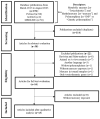Single-Nucleotide Polymorphisms Associated with Mercury Levels and Neurological Symptoms: An Overview
- PMID: 38535959
- PMCID: PMC10975854
- DOI: 10.3390/toxics12030226
Single-Nucleotide Polymorphisms Associated with Mercury Levels and Neurological Symptoms: An Overview
Abstract
Mercury (Hg) pollution is a global public health concern because of its adverse effects on the environment and health. Single-nucleotide polymorphisms (SNPs) have been associated with Hg levels and outcomes. The aim of this review was to describe the research and discuss the evidence on the genetic susceptibility of Hg-exposed individuals to the development of neurocognitive disorders. A systematic review was performed to identify the genes/SNPs associated with Hg toxicokinetics and that, therefore, affect neurological function in exposed populations. Observational and experimental studies were identified by screening three databases. Thirteen articles were included (quality score 82-100%) and 8124 individuals were evaluated. Hg exposure was mainly fish consumption (77%) and, in 31% of the studies, the Hg levels exceeded the reference limits. Genetic susceptibility to higher Hg levels and neurotoxicity risk in Hg poisoning were associated with eight (ALAD rs1800435, CYP3A4 rs2740574, CYP3A5 rs776746, CYP3A7 rs2257401, GSTP1 rs1695, MT1A rs8052394, MT1M rs2270836, and MT4 rs11643815) and three (MT1A rs8052394, MT1M rs2270837, and MT2A rs10636) SNPs, respectively, and rs8052394 was associated with both outcomes. The MT1A rs8052394 SNP may be used as a susceptibility biomarker to identify individuals at greater risk for higher Hg levels and the development of neurocognitive disorders in metal-exposed populations.
Keywords: environmental health; genetic polymorphism; mercury exposure; mercury poisoning; neurotoxicity; toxicokinetic.
Conflict of interest statement
The authors declare no conflicts of interest.
Figures



References
-
- National Human Genome Research Institute. [(accessed on 5 January 2024)]; Available online: https://www.genome.gov/genetics-glossary.
-
- National Human Genome Research Institute Polymorphism. [(accessed on 5 January 2024)]; Available online: https://www.genome.gov/genetics-glossary/Polymorphism.
-
- Basta P.C., Viana P.V.D.S., Vasconcellos A.C.S.D., Périssé A.R.S., Hofer C.B., Paiva N.S., Kempton J.W., Ciampi de Andrade D., Oliveira R.A.A.D., Achatz R.W., et al. Mercury Exposure in Munduruku Indigenous Communities from Brazilian Amazon: Methodological Background and an Overview of the Principal Results. Int. J. Environ. Res. Public Health. 2021;18:9222. doi: 10.3390/ijerph18179222. - DOI - PMC - PubMed
-
- Perini J.A., Silva M.C., Vasconcellos A.C.S.D., Viana P.V.S., Lima M.O., Jesus I.M., Kempton J.W., Oliveira R.A.A., Hacon S.S., Basta P.C. Genetic Polymorphism of Delta Aminolevulinic Acid Dehydratase (ALAD) Gene and Symptoms of Chronic Mercury Exposure in Munduruku Indigenous Children within the Brazilian Amazon. Int. J. Environ. Res. Public Health. 2021;18:8746. doi: 10.3390/ijerph18168746. - DOI - PMC - PubMed
Publication types
Grants and funding
LinkOut - more resources
Full Text Sources
Research Materials
Miscellaneous

